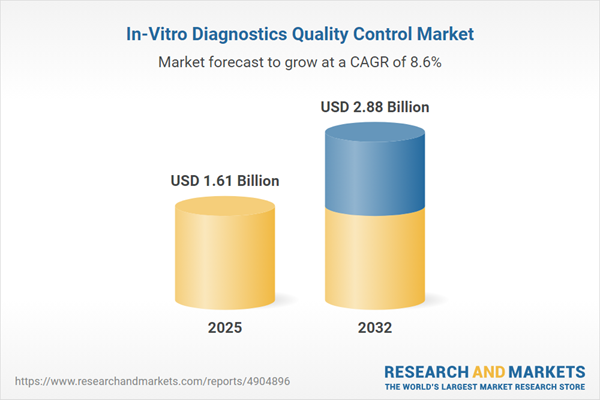Speak directly to the analyst to clarify any post sales queries you may have.
In-vitro diagnostics quality control is a pivotal element for laboratories seeking to ensure reliable test outcomes, enhance compliance, and maintain the robustness of healthcare operations. As digital transformation accelerates and regulatory expectations climb, leading organizations are strategically evolving their quality control frameworks to support sophisticated care delivery in dynamic environments.
Market Snapshot: In-Vitro Diagnostics Quality Control Market Overview
The global in-vitro diagnostics quality control market is witnessing sustained and notable growth, with a current valuation of USD 1.48 billion for 2024. Climbing projections—anticipated at USD 1.61 billion in 2025 and USD 2.88 billion by 2032—reflect stronger demand for precise diagnostic outputs, the integration of advanced laboratory systems, and increased adoption of digital health infrastructure. Regulatory reform is prompting laboratories to overhaul existing approaches, making modern quality control practices essential for adherence to evolving performance and safety benchmarks. Senior decision-makers are increasingly focused on procurement optimization, harmonizing laboratory processes, and ensuring their operations are both scalable and resilient in a shifting global landscape.
Scope & Segmentation: In-Vitro Diagnostics Quality Control
This report offers a detailed market breakdown, providing actionable segmentation for leadership teams pursuing optimized strategies and targeted growth:
- Product Types: Includes analyzers, spanning manual and automated quality control devices; liquid and lyophilized reagents; laboratory management software; and integrated data platforms for standardized laboratory oversight.
- Technology Categories: Encompasses clinical chemistry platforms, high-throughput hematology solutions, immunoassay systems such as ELISA and chemiluminescence, along with advanced molecular diagnostics supporting PCR and wide-spectrum disease detection.
- Applications: Covers a wide range of clinical fields including cardiology, genetics, prenatal screening, neonatal testing, infectious disease surveillance, oncology, and toxicology, each demanding precise quality protocols and regulatory adherence.
- End Users: Involves hospitals, blood banks, independent and reference laboratories, commercial testing centers, as well as research organizations, all characterized by unique operational priorities and compliance obligations.
- Regional Coverage: Addresses variances across North America, Europe, Asia-Pacific, and Middle East & Africa, where adoption rates, supply chain management, and regulatory structures influence competitive activity.
- Company Profiles: Highlights prominent industry players such as Bio-Rad Laboratories, Thermo Fisher Scientific, Abbott Laboratories, Roche Diagnostics, Danaher Corporation, Sysmex Corporation, Siemens Healthineers, Ortho Clinical Diagnostics, Randox Laboratories, and BioMérieux, recognized for their market leadership and ongoing sector advancements.
Key Takeaways for Senior Decision-Makers
- Automation within laboratory quality control delivers improved use of resources, enabling innovative diagnostics while minimizing staffing pressures.
- Digital platforms centralize oversight, providing actionable, real-time data to standardize processes and facilitate rapid, network-wide responses.
- Strong documentation and reporting systems help organizations adapt to regulatory changes and reduce exposure to audit risks.
- Flexible quality frameworks support diverse laboratory models, ensuring business agility amidst industry shifts and operational changes.
- Strategic alliances among technology vendors, research entities, and distribution partners unify professional standards and advance global management practices.
- Advanced analytics pinpoint workflow bottlenecks, allowing laboratories to stay ahead of operational demands and ensure compliance with shifting industry benchmarks.
Tariff Impact: Supply Chain and Cost Considerations
Recent U.S. tariff changes affecting laboratory apparatus and diagnostic reagents are influencing sourcing and purchasing patterns for healthcare providers. Procurement teams are responding by broadening supplier networks, renegotiating contracts, and fostering deeper collaboration with local distributors. This multi-pronged effort secures reliable access to critical in-vitro diagnostics quality control resources and reduces exposure to regulatory disruptions or external supply chain risks, ensuring laboratory operations remain uninterrupted and resilient.
Methodology & Data Sources
The report is built on insights from interviews with laboratory leaders, quality management specialists, and regulatory consultants. Findings are supported with peer-reviewed publications, industry white papers, and recognized guidelines, providing an independent and reliable analysis of in-vitro diagnostics quality control market dynamics.
Why This Report Matters
- Empowers organizations to accelerate digital integration and automation, boosting productivity and compliance for modern laboratory settings.
- Provides senior leaders with benchmarks and procurement insights to effectively navigate regulatory, operational, and supply chain trends.
- Facilitates informed, long-term capital allocation in harmony with broader market and organizational strategies, advancing strong, data-driven decision-making.
Conclusion
Embracing advanced in-vitro diagnostics quality control methods positions laboratories to maintain regulatory alignment, ensure operational continuity, and adapt quickly as industry standards develop and new challenges arise.
Additional Product Information:
- Purchase of this report includes 1 year online access with quarterly updates.
- This report can be updated on request. Please contact our Customer Experience team using the Ask a Question widget on our website.
Table of Contents
3. Executive Summary
4. Market Overview
7. Cumulative Impact of Artificial Intelligence 2025
Companies Mentioned
The companies profiled in this In-Vitro Diagnostics Quality Control market report include:- Bio-Rad Laboratories, Inc.
- Thermo Fisher Scientific Inc.
- Abbott Laboratories
- Roche Diagnostics International AG
- Danaher Corporation
- Sysmex Corporation
- Siemens Healthineers AG
- Ortho Clinical Diagnostics, Inc.
- Randox Laboratories Ltd
- BioMérieux S.A.
Table Information
| Report Attribute | Details |
|---|---|
| No. of Pages | 192 |
| Published | November 2025 |
| Forecast Period | 2025 - 2032 |
| Estimated Market Value ( USD | $ 1.61 Billion |
| Forecasted Market Value ( USD | $ 2.88 Billion |
| Compound Annual Growth Rate | 8.6% |
| Regions Covered | Global |
| No. of Companies Mentioned | 11 |









